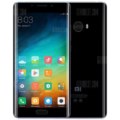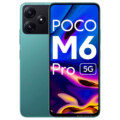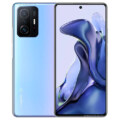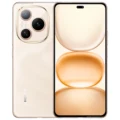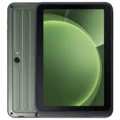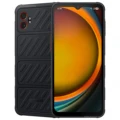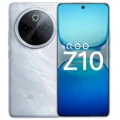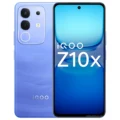Xiaomi Redmi 14C 5G
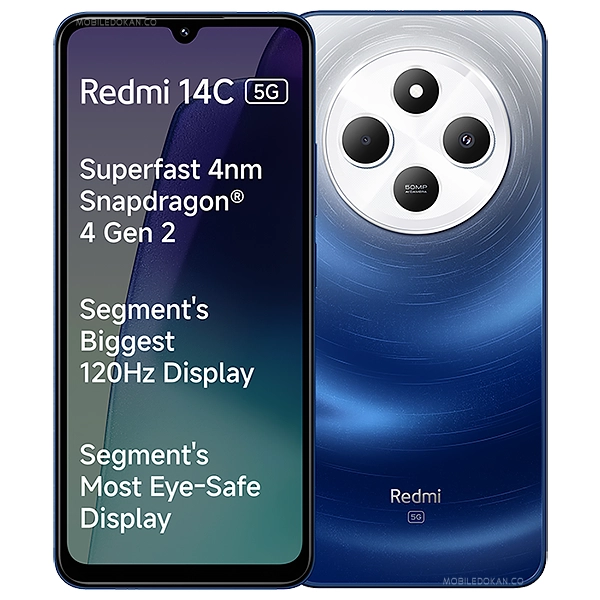


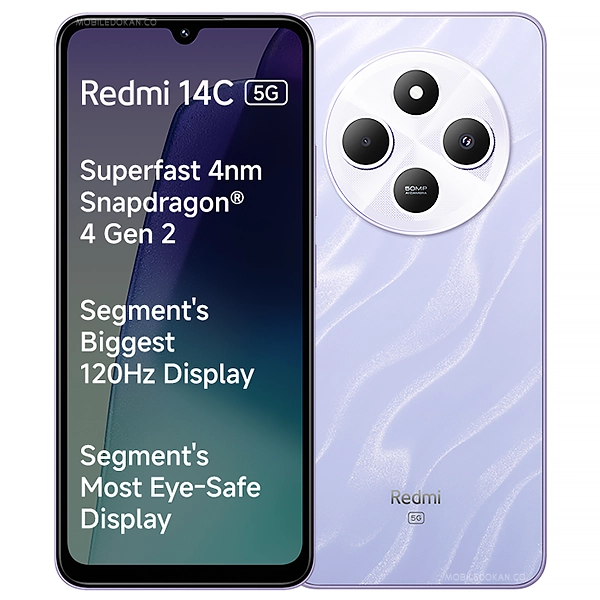








Pro and cons
Pros
- 6.88-inch with 120Hz refresh rate.
- Snapdragon 4s Gen 2 and 64/128GB ROM.
- 50MP main rear camera.
- Side-mounted Fingerprint scanner.
- 5160mAh battery with 18W charging.
Cons
- FM is not supported.
- 8MP selfie camera only.
- 4GB RAM varinat.
Specifications
Prices
| Expected price The expected price represents the anticipated cost of a product converted from major currencies like the Dollar, Euro, Yuan, and Rupee. | ৳20,000 |
Launch
| Announced | 2025, January 06 |
| Status | Available. Released 2025, January 10 |
Network
| Technology | GSM / HSPA / LTE / 5G |
| 2G bands It’s the 2nd generation mobile data communication technology. | GSM 850 / 900 / 1800 / 1900 - SIM 1 & SIM 2 |
| 3G bands It is the 3rd generation mobile data communication technology. | HSDPA 800 / 850 / 900 / 2100 |
| 4G bands It is the 4th generation mobile data communication technology. | LTE |
| 5G bands | 1, 3, 5, 8, 28, 40, 78 SA/NSA |
| Speed | HSPA, LTE, 5G |
Body
| Dimensions It's the size of the phone in format (H x L x W) and the volume of the phone where available. | 171.9 x 77.8 x 8.2 mm (6.77 x 3.06 x 0.32 in) |
| Weight | 205 g or 212 g (7.23 oz) |
| Build Describes the construction materials, methods and finishes used by the manufacturer when building a phone. | Glass front, plastic frame |
| SIM SIM (Subscriber Identity Module) is a small card that contains a mobile network subscriber's account information. This allows the phone to use the card to attach to a mobile network. The SIM card is most commonly associated with GSM and UMTS mobile networks. Moving a SIM card from one phone to another allows a subscriber to switch mobile phones without having to contact their mobile network carrier. SIM cards can also be used by a phone to store limited amounts of data, such as phone numbers and text messages. | Nano-SIM + Nano-SIM |
| Others | Splash and dust resistant |
Display
| Type A number of display technologies and types used in mobile phones TFT (Thin Film Transistor), IPS (In-Place Switching), OLED (Organic Light Emitting Diode), AMOLED (Active-Matrix Organic Light-Emitting Diode), Super AMOLED (an even advanced version of AMOLED), Resistive Touchscreen (Resistive touchscreens contain two-layer of conductive material with a very small gap between them which acts as a resistance), Capacitive Touchscreen (Capacitive touchscreen technology consists of a layer of glass coated with a transparent conductor) | IPS LCD, 120Hz, 450 nits (typ), 600 nits (HBM) |
| Size The industry-standard way of representing display sizes is publishing their length in inches. The screen-to-body ratio is a measure that relates to the size of the screen bezels. The bigger the ratio, the smaller the bezels are, meaning the display takes up a larger area on the device's front. | 6.88 inches, 112.4 cm2 (~84.0% screen-to-body ratio) |
| Resolution Display Resolution is the measuring way of how much pixels does a display contains. A higher resolution means more pixels and more pixels provide the ability to display more visual information (resulting in greater clarity and more detail). | 720 x 1640 pixels (~260 ppi density) |
Platform
| OS Every Mobile Phone system runs on a base software called Operating System (OS). Operating System controls all basic operations of the Mobile (such as smartphones, PDAs, tablet computers, and other handheld devices). The Operating System allows the user to install and run third party applications (apps), apps are used to add new functionality to the device. | Android 14, up to 2 major Android upgrades, HyperOS |
| Chipset It is a group of integrated circuits designed to perform one or more dedicated functions, often with real-time computing constraints, Popular smartphones are equipped with more advanced embedded chipsets that can do many different tasks depending on their programming. | Qualcomm SM4635 Snapdragon 4s Gen 2 (4 nm) |
| CPU CPU (Central Processing Unit) mostly known as processors, CPU processes instructions in order to carry out certain functions that make your device operate properly. Processors are often described as the brain of computers, smartphones and tablets, Smartphones and tablets rely on processors to carry out their every task, Processors are an incredibly important factor in selecting any type of computing device, including your smartphone. | Octa-core (2x2.0 GHz Cortex-A78 & 6x1.8 GHz Cortex-A55) |
| GPU GPU (Graphics Processing Unit) is a single-chip processor designed to rapidly manipulate and alter memory to accelerate the creation of images in a frame buffer intended for output to a display, This includes things such as lighting effects, object transformations, and 3D motion. | Adreno 613 |
Memory
| Card slot A special slot for inserting a memory card for expanding your storage. It is a special slot for inserting a memory card. Memory cards allow you to expand the phone's built-in memory, A memory card (sometimes called a flash memory card or a storage card) is a small storage medium used to store data such as text, pictures, audio, and video, for use on small, portable or remote computing devices such as mobile phones, mp3 players, digital cameras. | microSDXC (dedicated slot) |
| Internal Internal memory is the memory available onboard (chip or motherboard) which is given while manufacturing at the factory. is a data storage space (flash memory) mostly used in smartphones, tablets, and other electronic devices where operating system, apps, music, photos, videos, files, and other user data Is stored. | 64/128 GB UFS 2.2 |
| RAM RAM (Random Access Memory) is a type of mobile, computer memory that can be accessed randomly, any byte of memory can be accessed without touching the preceding bytes that allow information to be stored and accessed quickly from random locations. RAM is the most common type of memory found in computer systems, smartphones, tablets, and other electronic devices. | 4/6 GB |
| Variant | 4GB 64GB / 4GB 128GB / 6GB 128GB |
Main camera
| Single | 50 MP, f/1.8, 27mm (wide), PDAF Auxiliary lens |
| Features | LED flash, HDR |
| Video | 1080p@30fps |
Selfie camera
| Single | 8 MP |
| Video | 1080p@30fps |
Sound
| Loudspeaker Loudspeaker is a small sound driver fitted within a mobile phone, which is used to produce sound. | Yes |
| 3.5mm jack A common connector for plugging in audio output or input. | Yes |
Connectivity
| WLAN Wireless Local Area Network (WLAN) is a method of distributing data wirelessly to a local area network practically to the internet. It is a popular wireless networking technology using radio waves to provide high-speed network connections that allow devices to communicate without cords or cables, Wi-Fi is increasingly becoming the preferred mode of internet connectivity all over the world. | Wi-Fi 802.11 a/b/g/n/ac, dual-band |
| Bluetooth Bluetooth is a wireless technology standard for exchanging data over short distances from fixed and mobile devices. It is a wireless communications technology for exchanging data between mobile phones, headsets, computers, and other network devices over short distances without wires, Bluetooth technology was primarily designed to support simple wireless networking of personal consumer devices. | Yes |
| GPS GPS (Global Positioning System) originally Navstar GPS, is a satellite-based radio navigation system. It is a satellite-based radio navigation system, GPS permits users to determine their position, velocity, and the time 24 hours a day, in all weather, anywhere in the world, In order to locate your position, your device or GPS receiver must have a clear view of the sky. | GPS, GLONASS, GALILEO, BDS |
| NFC NFC (Near Field Communication) is a shorter range of high-frequency data transferring technology. It is a set of standards for smartphones and similar devices to establish peer-to-peer radio communications with each other by touching them together or bringing them into proximity, usually no more than a few inches. | No |
| FM radio FM broadcasting is a method of radio broadcasting using frequency modulation technology. | Unspecified |
| USB USB is a standard for a wired connection between two electronic devices, including a mobile phone and a desktop computer. | USB Type-C 2.0 |
| Infrared port IrDA (Infrared Data Association) is an old data sharing technology in the means of Infrared Port. It uses a beam of infrared light to transmit information and so requires a direct line of sight and operates only at close range. |
Features
| Sensors A sensor is a device, module, or subsystem whose purpose is to detect events or changes in its environment and send the information to other electronics. The specific input could be light, heat, motion, moisture, pressure, and location, The output is generally a signal that is converted to use in computing systems, a location sensor, such as a GPS receiver is able to detect the current location of your electronic device. | Fingerprint (side-mounted), accelerometer, compass Virtual proximity sensing |
Battery
| Type Cell phones run on various kinds of batteries depending on the manufacturer, phone size or shape, and features. There are basically four types of cell phone batteries Lithium Polymer (Li-Po), Lithium-Ion (Li-Ion), Nickel Metal Hydride, and Nickel Cadmium. | Non-removable Li-Po |
| Capacity The unit of capacity is milliamp-hours (mAh), which means 3000mAh can be put on the battery to discharge it in one hour. The battery capacity represents the maximum amount of energy that can be extracted from the battery under certain conditions. | 5160 mAh |
| Charging | 18W wired, PD |
More
| Made by | China |
| Color | Stardust Purple, Starlight Blue, Stargaze Black |
Disclaimer
We do not guarantee that the information of this page is 100% accurate and up to date.
Xiaomi Redmi 14C 5G Price in Bangladesh April 2025
The Xiaomi Redmi 14C 5G is now available in two variants (64/128GB/4/6GB RAM). The Xiaomi Redmi 14C 5G’s Price is 20000 Taka in Bangladesh. Redmi 14C 5G has a 5160mAh battery that is 18W fast charging. This device runs Android 14 and is powered by the Qualcomm SM4635 Snapdragon 4s Gen 2 (4 nm) chipset.
| Model | Xiaomi Redmi 14C 5G |
| Price | BDT. 20,000 |
| Display | 6.88″ 720×1640 pixels |
| RAM | 4/6 GB |
| ROM | 64/128 GB |
| Released | 2025, January |
Xiaomi Redmi 14C 5G highlight
Xiaomi Redmi 14C 5G will be launched in January 2025. The Redmi 14C 5G was launched with the model number unknown. Firstly, Its dimensional measure is 171.9 x 77.8 x 8.2 mm, and its weight is 205 grams. Secondly, the Redmi 14C 5G display is a 6.88-inch IPS LCD panel with 720 x 1640 pixels resolution. The display is protected with Corning Gorilla Glass. Thirdly and most importantly, it is powered by the Qualcomm SM4635 Snapdragon 4s Gen 2 (4 nm) and runs on Android 14. Moreover, it has an Octa-core (2×2.0 GHz Cortex-A78 & 6×1.8 GHz Cortex-A55) CPU.
Xiaomi Redmi 14C 5G phone has a single-camera setup on the back. This formation consists of 50MP wide cameras. It has a 5MP selfie camera inside the punch hole of the display. The video recording capability is 1080p@30fps. Its RAM and ROM have two (64/128GB/4/6GB) variants. On the other hand, it can not support microSDXC on using a shared SIM slot. Certainly, Redmi 14C 5G has a 5160mAh battery with 18W fast charging. It has a dual nano-SIM card slot. Redmi 14C 5G is 2G/3G/4G/5G supportable. The fingerprint sensor is side-mounted.
On the other hand, it has WLAN, Bluetooth, a USB port, and Face unlock, among other features.
Your question and our opinion about the Redmi 14C 5G
Which question you will have about this phone? Let’s justify these. There, we are including the major questions and answers about this phone. So, let’s start now.
It will launch in January 2025.
The price of the Xiaomi Redmi 14C 5G is BDT. 20,000.
It has two variants of 4/6GB in RAM and 64/128GB in ROM. Overall, the market offers three variants (64GB/4GB, 128GB/4GB, 128GB/6GB).
It has a 6.88″ IPS LCD Display panel with 720 x 1640 pixels resolution.
The back has a single camera setup: a 50MP and a 5MP selfie camera. The video recording capability is 1080p@30fps.
It contains Qualcomm SM4635 Snapdragon 4s Gen 2 (4 nm) chipset and Android 14. It has up to an Octa-core (2×2.0 GHz Cortex-A78 & 6×1.8 GHz Cortex-A55) CPU.
It supports a 5G network with 2G / 3G / 4G.
The battery capacity is a 5160mAh Li-Polymer battery with 18W fast charging.
Fingerprint, accelerometer, compass sensors.
Xiaomi manufactured it and this phone is made in China.
Reason to Buy
In this paragraph, we will describe the important reasons why people buy this smartphone. Why did a person buy this smartphone? Firstly, when anyone wants to buy a device, they look for premium features according to their price. So, let us find out some eligible items in the Redmi 14C 5G.
Our Verdict
In conclusion, we are giving our verdict on this device. Suppose you want to buy the best 5G smartphone under 25K Taka. Then, Xiaomi Redmi 14C 5G will be in the first row among the best smartphones. Dear friends, if you are interested in online games like Free Fire, you can buy them because they have RAM and a good processor that uses the Qualcomm SM4635 Snapdragon 4s Gen 2 (4 nm) chipset. If you want a great backup on charge, you can buy this because it has a massive 5160mAh battery. In addition, it’s a 5G supportable smartphone. So, you can get good network facilities on it. However, it has a single-cam setup with a 50MP primary camera. So, the image and video capabilities may be good. Therefore, to judge all of these reasons you can buy this.
